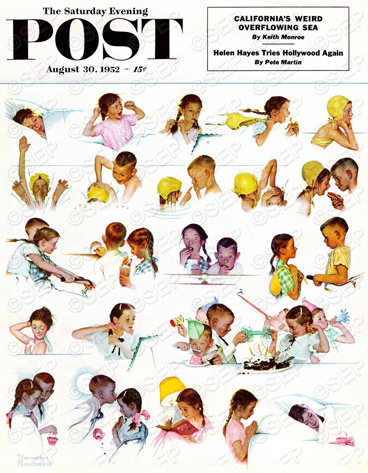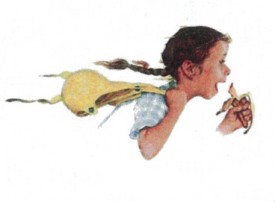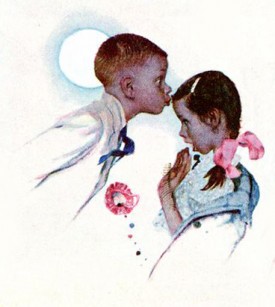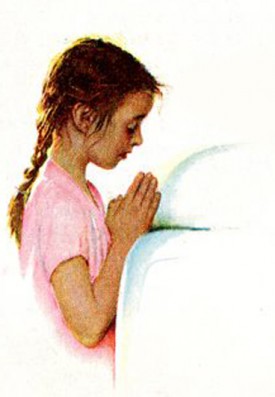Hospice Girl Friday | ‘The Power of Listening’
Devra Lee Fishman’s dear friend and college roommate, Leslie, died from breast cancer one month shy of her 46th birthday after a four-year battle with the disease. Being with Leslie and her family at the end of her life inspired Devra to help care for others who are terminally ill. Each week, she documents her experiences volunteering at her local hospice in her blog, Hospice Girl Friday.
There was a woman in the hospice’s communal living room when I came in to start my shift. She was wearing navy blue sweatpants, a pale gray t-shirt and slippers. She was slumped on the sofa, facing the television but staring at something much further away. After I put my bags down under the volunteer desk I checked the list of current patients and then asked one of the nurses about the woman on the sofa.
“Her sister is in room three,” the nurse replied. “Fifty-eight years old. Colon cancer. They’ve both been here since yesterday morning.”
Once I settled in, I walked over to the woman and introduced myself. She told me her name was Mary.
“I understand you’re Ann Simpson’s sister,” I said as I perched myself on an arm of the chair next to her, careful not to assume she wanted company.
“I am,” she said as she sat up and straightened out her t-shirt, which had bunched up against the sofa behind her. “She’s my baby sister, and I’ve been taking care of her the whole time she’s been sick, which feels like forever. I’ve gone to every doctor’s appointment, every treatment, and now we’re here.” She swept her eyes around open space and then slowly shook her head.
“How wonderful you’re able to be with her,” I said, acknowledging that caregivers need to know someone cares about them and the effort they make. Mary looked back up at me and nodded. “Yes,” she said. Her mouth hung open like she was going to say more, but she didn’t.
“The nurse said Ann is resting comfortably,” I said. “How are you holding up?”
“I’m fine,” Mary said. “Tired. It’s been a long six months since Ann was diagnosed. And tomorrow is my 60th birthday. I’d hate for her to die on my birthday, but if she needs to go, she needs to go. She’s been through enough.”
Since she answered more than my question, I slid down into the chair and waited for her to continue.
“Ann’s husband is coming over later this morning so I can go home and get some stuff done,” Mary said. “Then I’ll be back to spend the night again.”
I wondered if she wanted to talk some more, so I searched around for a question that would open up more of Ann’s story. “What kind of work did Ann do?” I asked.
“She was a school teacher,” Mary said. “Fifth grade. She loved her kids and her kids loved her. Never had children of her own, so they were her family.” I nodded slowly as she spoke. She continued, staring at a space somewhere between the two of us. The words spilled out as though they had been backed up for a while.
“I work for the power company. My manager has been very understanding and has given me a lot of flexibility so I can take care of Ann.”
We sat and chatted like that for about fifteen minutes. I would have happily stayed there for my entire shift, but Mary said she wanted to check on Ann. I stood with her and told her I would stop by in a little while to see if she needed anything. Maybe I could get her to tell me more about her sister, I thought.
I have always enjoyed learning people’s backstories, but once I became a hospice volunteer I made it a point to learn as much about the patients from their loved ones as I could. Talking about people who are dying helps us to lock in memories of who they were–and who we were–when everyone was healthy and living their everyday lives. I learned this from the experience I had with my friend Leslie, who died in 2006.
I will always cherish the time I spent with Leslie during the four years she fought breast cancer, and it was my honor to be with her at the very end of her life. But when I talk about her now I have to work hard to replace the picture of her as she lay on her death bed with one of the gazillion (she loved to exaggerate so Leslie, this one’s for you) mental images I have of who she was during the nearly 30 years that we were friends. Maybe we’re programmed to more easily recall extraordinary moments, such as the birth or death of a loved one, but I think it’s just as important to remember the string of ordinary images and moments that tell the whole story of how we lived. I want that for myself, and I want that for the people I meet in the hospice.
I made my rounds later in my shift, and when I walked into room three Mary was sitting in an armchair next to Ann’s bed and holding her hand. Ann seemed to be sleeping comfortably, but the blanket covering her moved only slightly as she took shallow, infrequent breaths, indicating that she was nearing the end. Mary watched me as I studied her sister. I wondered if it would help Mary to talk more about Ann, so I asked, “Were the two of you close growing up?”
And with that question, Mary took me back to their childhood (Ann taught Mary how to ride a bike), their weddings (they were each other’s maid of honor) and their families (they’ve lived on the same street for 25 years). Mary also told me she always thought Ann was the prettier one, and she said that the two of them took care of their mother together, who died from Alzheimer’s just last year.
I stayed with Mary and Ann until my shift ended, grateful for the picture Mary drew of the ordinary moments they shared throughout their lives. I hope talking about Ann with me will help Mary bring those memories forward every time she thinks about her beloved sister.
Previous post: Coming Home to Say Goodbye Next post: Survivor’s Guilt
Rockwell’s Favorite Model, Part II
Day in the Life of a Girl
Norman Rockwell
August 30, 1952
Rockwell said he enjoyed working with 9-year-old Mary Whalen, who “could look sad one minute, jolly the next, and raise her eyebrows until they almost jumped over her head.”
“He was very inclusive; he wasn’t authoritarian, telling me what to do,” Mary says. “It was, ‘OK, this is what we’re going to do today.’ He would act it out for me.
“I was reserved and he would just sort of pull [the expressions] out of me by laughing or clapping or stomping his feet or jumping up and down and making me laugh, that kind of thing. And I just felt such a part of what was happening. As a kid, I liked to be a part of something. He knew what he wanted and he knew how to get that out of you. And then when he got [the right expression], he would just shout, ‘Oh, that’s wonderful! That’s wonderful!’”
For the 1952 cover, A Day in the Life of a Girl, Mary gave Rockwell over 20 wonderful expressions.
“It took a week,” Mary tells us, to shoot all the scenes for the 1952 cover. Beginning with getting out of bed, A Day in the Life of a Girl is done sequentially, like a movie reel. Photographer Gene Pelham took dozens of shots, as the artist posed his models.
“When I posed for A Day in the Life of a Girl,” Mary tells us, “I got up early, my mother combed my hair, did my braids, and off we went [to Rockwell’s studio].” The first thing Rockwell said to them was, “We’re going to mess up Mary’s hair,” and with that he tousled her tidy braids.
The first six scenes were completed that first day. For this flying out the door on her way to go swimming look, her mother had to hold her pigtails back, while someone else pulled back her swimming cap. When the angles were just right, “Rockwell would yell, ‘Get it!’” Mary says, and Pelham would snap away.
The scene below depicts the old story: Boy meets girl, boy tries to drown girl, spunky girl bawls him out, and then gives him a taste of his own medicine. Ah, young love!
The boy in the love story is Chuck Marsh, another model with a wonderfully expressive face. He was in the earlier Rockwell cover, A Day in the Life of a Boy.
In real life, Mary tells us, she and Chuck never posed in a pool—it was all done in the studio. And when we asked about the dripping wet hair, Mary gave us a glimpse into the glamorous world of modeling: “They poured a bowl of water on me.”
The kids never pushed each other’s heads down either. “We used a bronze bust to lean on … to get the elbow right,” Mary reveals, then adds, “I went to the Rockwell Museum three or four years ago, and they still had that bust in his studio!”
[You can tour the artist’s studio at The Norman Rockwell Museum in Stockbridge, Massachusetts, or take the online tour here.]
Gradually, boy and girl become friends, go for a bike ride and a movie, and then we find them at a birthday party. In this scene, Mary is wearing a party dress Rockwell bought for her. But what sounds like an act of kindness was most likely the artist’s insistence on just the right details. As an example, he shopped several furniture stores for the exact chair he wanted for his delightful Easter Morning cover from 1959.
The party scene involved more models, including Mary’s twin brother, Peter; and Chuck Marsh’s little brother, Donnie, whose mission was simply to devour the cake and ice cream. Donnie’s single-mindedness about the treats made for a difficult day’s shoot, Mary recalls.
Ten-year-old Chuck Marsh noted that this scene was the “toughest time” he ever had posing. He liked Mary very much, but no how, no way was he going to kiss a girl. “Mr. Rockwell finally gave up trying to get me to kiss her,” he said, and the artist posed the two separately. Getting the smooch just right involved Chuck leaning toward—you guessed it—that bronze bust. Who knew the head of a Classical figure could be so utilitarian?
At the end of this long day, Mary is dressed for bed and writing in her diary, no doubt about that moonlit kiss. And the painting is almost complete.
But there was a problem when Rockwell reached his final scene. With the deadline almost upon him, he remembered the many complaints he had received about one aspect of A Day in the Life of a Boy—before retiring for the night, the boy did not say his prayers. So Rockwell called the Whalens and said, “You’ve got to get Mary down here!”
Because the prayer scene was added, another scene was taken out, Mary tells us. Deleted was a charming scene of Mary and Chuck smiling and thanking their hostess (the birthday girl in the pink hat in the party scene above). But the day is done, bedtime prayers said, and Mary drifts off to sleep with a smile on her face and a party favor beside her.
Previous: Rockwell’s Favorite Model
Next: The third and final installment of Rockwell’s Favorite Model, featuring a coming-of-age cover many feel is one of the artist’s finest works.






